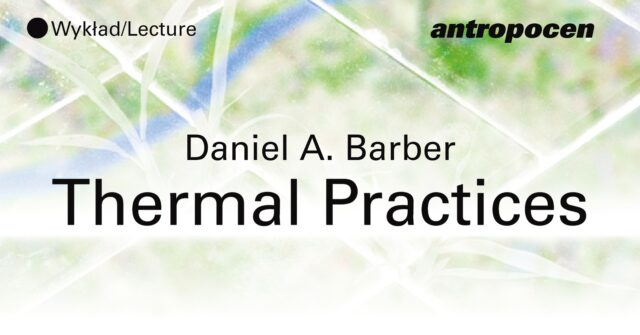
Wykład w języku angielskim
Thermal Practices explores how both designers and inhabitants are involved in the thermal performance of a building: design practice provides a framework while the user’s daily practices realise (or not) the potential of the project. These two forces (design and use) intersect around the issue of comfort. One hallmark of architecture since the 1960s is that thermal comfort – the humidity, temperature, and air quality of the interior – is often provided through hydrocarbon-fuel intensive heating, ventilating, and air-conditioning (HVAC) systems. Indeed, the recent challenge of performance is: how can a building provide adequate comfort while reducing carbon emissions? This challenge is essential to achieving carbon-neutrality by 2050. It entails paying attention to fuel sources, to design techniques for fuel-efficiency, and to adjusting the expectations of the inhabitant. This presentation will provide a history of architecture as a thermal practice and explore the resonance of these concerns for the ongoing climate emergency.
The lecture will be delivered in english, the event will take place in the ZODIAK Warsaw Pavilion of Architecture at Pasaż „Wiecha” 4 in Warsaw.
When: 22.11, 18.00
Daniel A. Barber – is Professor of Architecture at the University of Technology Sydney (UTS) and a Research Affiliate at the Max Planck Institute for the History of Science in Berlin. His research and teaching focus on how the practice and pedagogy are changing to address the climate emergency. Daniel has held academic positions and fellowships at Harvard, Penn, Princeton, and Yale, and at the Instituto Universitário de Lisboa, the Rachel Carson Center (Munich) and most recently as a Senior Research Fellow at the Centre for Apocalyptic and Post-Apocalyptic Studies (CAPAS) at the Universität Heidelberg. He is a 2022-2023 Guggenheim Fellow, working on the project Thermal Practices. His most recent book is Modern Architecture and Climate: Design before Air Conditioning (Princeton University Press, 2020), following on A House in the Sun: Modern Architecture and Solar Energy in the Cold War (Oxford University Press, 2016). His essay “After Comfort” (Log 49, 2019) has been translated into three languages; it forms the basis for an exhibition at the 2023 COP meeting in Dubai, and for a forthcoming series of essays and projects on the e-flux architecture online platform. He is co-founder of the Current: Collective on Environment and Architectural History, and co-editor of the annual Accumulation series on e-flux architecture, now also in a print volume. He recently co-edited a special issue of Future Anterior focused on preservation and retrofit, and is part of the Cohabitations editorial collective, supporting interdisciplinary and multi-sited research on climate, displacement, and design.
____________________________________________________
Projekt „Thermal Practices” bada, w jaki sposób zarówno projektanci jak i mieszkańcy biorą udział w obiegu ciepła w budynku: biuro projektowe zapewnia ramy w postaci projektu, podczas gdy codzienne działania użytkowników wykorzystują (bądź nie) potencjał owego projektu. Te dwie siły (projektowanie i użytkowanie) krzyżują się wokół kwestii komfortu. Cechą charakterystyczną architektury od lat 60. XX wieku jest to, że komfort termiczny—wilgotność, temperatura i jakość powietrza we wnętrzu—jest często regulowany poprzez systemy grzewcze, wentylacyjne i klimatyzacyjne (HVAC), zużywające duże ilości paliwa węglowodorowego. Zatem najnowsze wyzwanie związane z wydajnością brzmi: w jaki sposób budynek może zapewnić odpowiedni komfort mieszkańcom przy jednoczesnej redukcji emisji dwutlenku węgla? Wyzwanie to ma zasadnicze znaczenie dla osiągnięcia neutralności pod względem emisji dwutlenku węgla do 2050 roku. Wiąże się z koniecznością zwrócenia szczególnej uwagi zarówno na źródła paliwa jak i na techniki projektowe zapewniające efektywność paliwową, oraz na dostosowanie oczekiwań mieszkańców. Niniejsza prezentacja poświęcona historii architektury z punktu widzenia zarządzania ciepłem wskaże jak powyższe obawy rezonują z trwającym kryzysem związanym z katastrofą klimatyczną.
Wykład w języku angielskim; wydarzenie odbędzie się w Warszawskim Pawilonie Architektury ZODIAK przy Pasażu “Wiecha” 4 w Warszawie.
Kiedy; 22.11, godz. 18.00
Daniel A. Barber – profesor architektury na Uniwersytecie Technologicznym w Sydney (UTS), członek zespołu badawczego w Max Planck Institute for the History of Science w Berlinie. Do badań i nauczania prof. Barber podchodzi interdyscyplinarnie: łączy narracje i metody typowe dla historii architektury, sztuki, architektury krajobrazu, technologii, polityki, ekonomii i ochrony środowiska. Jego zainteresowania naukowe skupiają się wokół historii architektury modernizmu w kontekście zagrożeń ekologicznych oraz na tworzeniu ram teoretycznych pomocnych architektom i przedstawicielom innych profesji zaangażowanym w rozwiązywanie problemu kryzysu klimatycznego. Jego najnowsza książka to “Modern Architecture and Climate: Design Before Air Conditioning” [Współczesna architektura i klimat: projektowanie przed erą klimatyzacji; Princeton University Press, 2020], poprzednia natomiast to “A House in the Sun: Modern Architecture and Solar Energy in the Cold War” [Dom w słońcu: współczesna architektura i energia słoneczna w dobie zimnej wojny; Oxford University Press, 2016]. Jego esej pt. „After Comfort” [Komfort już był; „Log 49”, 2019) został przetłumaczony na trzy języki i stanowi bazę wystawy podczas spotkania COP w 2023 roku w Dubaju oraz czekającej na publikację serii esejów i projektów na platformie internetowej e-flux architecture. Prof. Barber jest współzałożycielem Current: Collective on Environment and Architectural History, oraz współredaktorem rocznika „Accumulation” poświęconego architekturze e-flux, teraz również w formie drukowanej. Niedawno współredagował specjalne wydanie „Future Anterior” poświęcone konserwacji i retrofitowi. Jest członkiem kolektywu redakcyjnego Cohabitations, wspierającego interdyscyplinarne i wielowątkowe badania nad klimatem, przemieszczeniami i projektowaniem.


